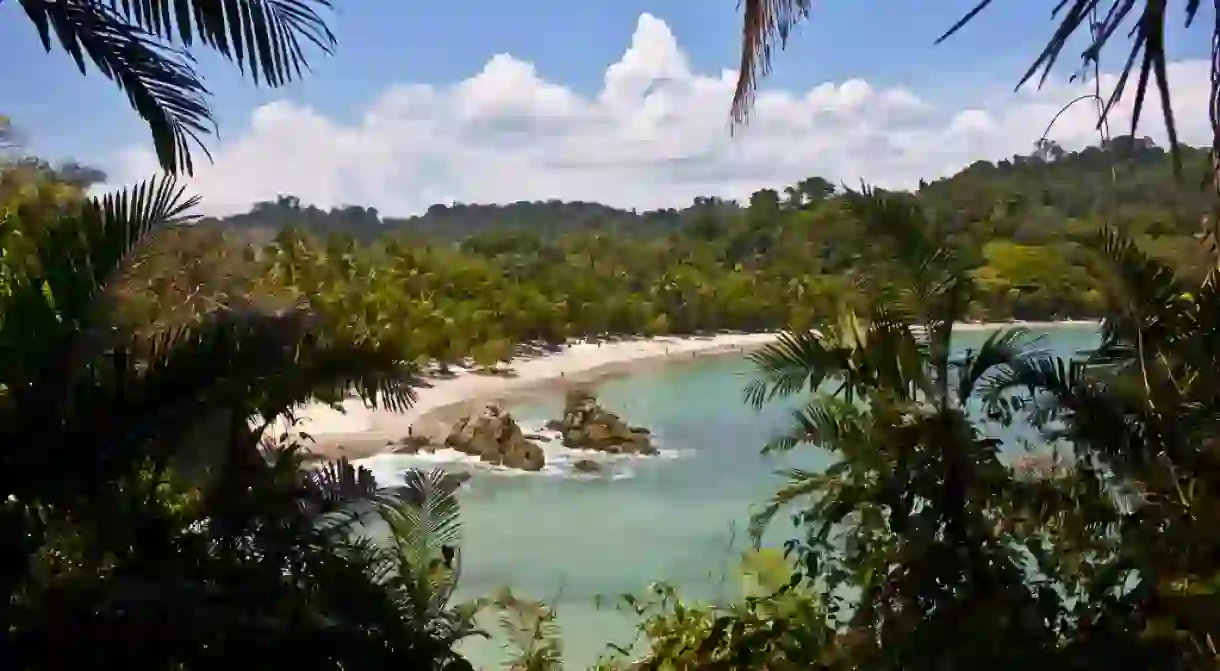An Insider's Guide to Manuel Antonio National Park

Costa Rica‘s Manuel Antonio National Park, close to Quepos in the province of Puntarenas, is one of the most biodiverse national parks in the world. If you want to see monkeys, sloths, vibrant macaws in their lush natural habit and experience the most beautiful beaches in the country, take a look at our guide to this must-visit destination.
A brief introduction
Manuel Antonio National Park was established in 1972. It is Costa Rica’s smallest national park, covering 683 hectares (1,700 acres) of protected land and 55,000 hectares (136,000 acres) of protected marine territory, and comprises tropical forests, mangrove forests, lagoons, pristine beaches, and vibrant reefs. There are 109 species of mammals and 184 species of birds, as well as an abundance of amphibians, reptiles, and marine species that call Manuel Antonio home. There are also 12 isles off of the coast that are frequently passed by migrating whales and dolphins.
Planning a visit
The park is open from Tuesday to Saturday, from 7.30am-4pm. If you are looking to avoid the crowds, visiting the park between May and November and early in the morning is your best bet. There is a $16 park admission fee (children under 12 are free) if you want to explore the park without a naturalist guide – though if you’re visiting for the first time, their wealth of information about the local flora and fauna can shed a whole new light on the experience.
Take a tour
The best way to experience the park is by taking a 2 1/2-3 hour guided nature tour and hike. You can join a tour at the entrance to the park – group tours cost $51 for adults and $33 for children, while private tours are $71 for a adults and $55 for children. The tour guides employed by the park are professional and highly experienced naturalists who will be able to point out animals and plants that you may miss if visiting on your own. They will also be able to share fascinating information regarding the wildlife, plant life, and history of the park.

Self-guided hiking
If you opt to explore solo, there are two main trails through the park that are well-marked and well-maintained. The main trail is 2km (1.3 miles) long and is a flat and easy hiking path that takes you through the park and out to the beaches. The second trail is a 1.5km (0.9 mile) loop that is a bit more challenging, with steep inclines in parts. Both trails offer an opportunity to spot wildlife amid the mesmerizing beauty of the park. Keep your eyes peel for sloths in particular, as they are known to be perfectly camouflaged amid the trees.

Relax on the beach
There are four beaches in the national park that are said to be the most beautiful and picturesque in all of Costa Rica: Playa Manuel Antonio (the main beach, a 30-minute hike from the entrance to the park), Playa Espadilla Sur, Escondito, and Playita. There is something incredibly surreal and magical about emerging from the rainforest onto a pristine protected beach – pack a picnic and spend the afternoon swimming, snorkeling, or surfing.

Explore the protected marine territory
The are multiple different ways to explore underwater, with fantastic snorkeling and diving tours, ocean kayaking, mangrove boat tours, and sailing excursions. The waters around Manuel Antonio are teeming with marine wildlife – it is quite common to spot whales, dolphins, and sea turtles too.
Hop over to Damas Island
While you are in the area, try the highly recommended Damas Island mangrove boat trip. You can either go by small motorized boat, or you can kayak there. Cruise slowly through the waterways that cut through the mangrove forests, surrounded by the peaceful embrace of nature, and take in sights including monkeys, sloths, and crocodiles. The tour leaves from Quepos, allowing time enough on the journey to the island for an informative low-down from your guide on the city’s facinating culture and history.













